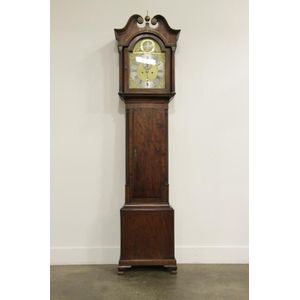George III Mahogany Long Case Clock with Hand-Painted Dial
You must be a subscriber, and be logged in to view price and dealer details.
Subscribe Now to view actual auction price for this item
When you subscribe, you have the option of setting the currency in which to display prices to $Au, $US, $NZ or Stg.
- Date Aperture - A date aperture is a cut out section in the face of a watch or clock, displaying the day of the month.
- Pendulum - The pendulum was discovered around 1602 by Galileo Galilei, and was adopted for time keeping by the Dutch mathematician and natural philosopher, Christiaan Huygens, who excelled in astronomy, physics, and horology.
The pendulum comprises a metal rod usually of brass or steel with a metal disk, known as a bob, at the end. The movement of the pendulum is driven by weights or a spring, and as a pendulum swings in a regular arc, it was found accuracy could be controlled to within a few seconds a week.
Timekeeping can be adjusted by changing the height of the bob on the rod, making the pendulum either swing slower or faster.
The disadvantage of the pendulum was that changes in temperature also changed the length of the pendulum, interfering with the accuracy of the clock, and so in the 18th century two types of mercurial pendulums were invented which countered the movement in the steel rod.
The pendulum was the world's most accurate timekeeping technology until the invention of the quartz clock, regulated by a quartz crystal, in 1927. - George Iii - George III (1738 - 1820) was King of Great Britain and Ireland from 1760 to 1820.
- Mahogany - Mahogany is a dense, close grained red-coloured timber from the West Indies and Central America. It was first imported into Europe in the the early 18th century and its use continued through the 19th century. It was popular for furniture making because of its strength, the wide boards available, the distinctive grain on some boards, termed flame mahogany and the rich warm colour of the timber when it was polished.. The "flame" was produced where a limb grew out from the trunk of the tree, and this timber was usually sliced into veneers for feature panels on doors, backs and cornices.
Some terms used to describe mahogany relate to the country from which it originally came, such as "Cuban" mahogany, "Honduras" mahogany etc. However unless the wood has been tested the names assigned are more a selling feature, rather than a true indication of the timber's origin. - Broken Arch - An arch at the top of the clock, usually of half circle shape where the diameter is less than that of the frame from which it rises. The area in the broken arch may contain one or more subsidiary dials, the makers name, strike / silent mechanism, automata, phases of the moon or a painted scene. This design feature is found mainly on bracket clocks and longcase clocks.
This item has been included into following indexes:
Visually similar items

Antique English long case clock, movement by Jas Roberts (Bath) painted arched dial, with sub seconds, and calendar aperture, ebony inlaid mahogany case, approx 210 cm high

A fine inlaid long case mahogany moon phase clock, early 19th century, marked Osborne to rear of dial, clock face manufacturers, with an arched broken pediment, engraved brass and spandrel decorated dial with a brushed steel chapter ring and Roman numerals

A Georgian oak and mahogany cased arch brass dial and painted panel grandfather clock. Maker: John Laurence of Lancaster. 231 cm high, 50 cm wide, 25 cm deep.

An early 19th century mahogany cased grandfather clock the brass dial with a silvered chapter ring signed Geo. Bruce London. Height 218 cm. Width 45 cm. Depth 22 cm
